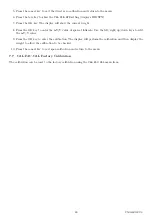
7.5
Linearisation
Up to 10 linearisation points can be set independently anywhere in the operating range of the scale. Unused
points may be cleared.
Warning!
Linearisation changes the signal resolution. If this is close to the limit, it should
be checked.
7.5.1
CAL:ED.LIN Add Linearity Point
1. A zero and span calibration must be done before linearisation. Zero and span are assumed to be accurately
set and have no linearisation error.
2. Go to
CAL:ED.LIN
in the setup menus.
3. Press the gross/net key. The list of linearisation points will be shown.
4. Select a linearity point. Press the gross/net key until the correct linearity point is shown, then press the
OK key. The display will show the current weight. Add the test weight to the scale.
5. Press the OK key to enter the actual weight on the scale. Use the left/right/up/down keys to edit the
weight if required.
6. Press the OK key to start the calibration. The display will show (L IN P) to show that calibration is in
progress. When the process is complete the display will show the weight to allow the calibration to be
checked.
7. Press the cancel key to exit calibration and return to the menu.
7.5.2
CAL:CLR.LIN Clear Linearity Point
1. Go to
CAL:CLR.LIN
in the setup menus.
2. Press the gross/net key to view the linearity points. The percentage of fullscale where the point was
entered is shown.
3. Press the gross/net key until the unwanted linearity point is shown.
4. Press the OK key to clear the linearity point. The indicator will prompt with “CONT N”. Use the up
and down keys to select “Y”, followed by the OK key to clear the linearization point and return to the
menu. To exit without clearing, select “N”.
7.6
Direct mV/V Calibration
It is possible to enter the mV/V values of zero and span directly. The internal mV/V accuracy of the indicator
has a tolerance of 0.1
Calibration procedure:
1. Go to
CAL:DIR.ZER
in the setup menus: enter full setup (see Section 5.1.2); press the zero key until CAL
is shown; press the tare key to show the
CAL:DIR.ZER
setting (displays DIR.ZER).
2. Press the OK key. The display will show the current weight.
3. Press the OK key to enter the mV/V value of the scale with no load. Use the left/right/up/down keys
to edit the mV/V value.
4. Press the OK key to enter the calibration. The indicator will perform the calibration and then display
the weight to allow the calibration to be checked.
45
C500-600-2.0.3
Summary of Contents for C500 series
Page 1: ...C500 Series Digital Indicator Reference Manual ...
Page 54: ...8 3 Custom Format Tokens 8 3 1 Formatting 49 C500 600 2 0 3 ...
Page 56: ...230 Send time in format hh mm ss 231 Send Date in format dd mm yyyy 51 C500 600 2 0 3 ...
Page 123: ...118 C500 600 2 0 3 ...
Page 182: ...177 C500 600 2 0 3 ...
















































